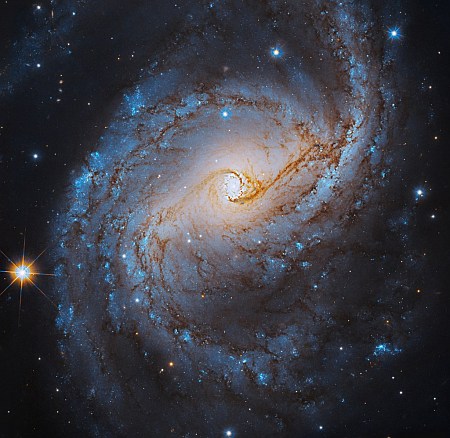A nearby active galaxy, viewed head on by Hubble
Cool image time! The picture to the right, reduced and sharpened to post here, was taken by the Hubble Space Telescope and is the third of a seven-day celebration of galaxies by the Hubble science team. Previous images in the series can be found here. From the caption for this particular image:
At the center of NGC 6951 lies a supermassive black hole surrounded by a ring of stars, gas, and dust about 3,700 light-years across. This “circumnuclear ring” is between 1 and 1.5 billion years old and has been forming stars for most of that time. Scientists hypothesize that interstellar gas flows through the dense, starry bar of the galaxy to the circumnuclear ring, which supplies new material for star formation. Up to 40 percent of the mass in the ring comes from relatively new stars that are less than 100 million years old. Spiral lanes of dust, shown in dark orange, connect the center of the galaxy to its outer regions, contributing more material for future star formation.
This galaxy, located about 78 million light years away, has also seen six different supernovae in the past quarter century. Compare that with the Milky Way, which has not seen a supernova now in more than four hundred years.
On Christmas Eve 1968 three Americans became the first humans to visit another world. What they did to celebrate was unexpected and profound, and will be remembered throughout all human history. Genesis: the Story of Apollo 8, Robert Zimmerman's classic history of humanity's first journey to another world, tells that story, and it is now available as both an ebook and an audiobook, both with a foreword by Valerie Anders and a new introduction by Robert Zimmerman.
The ebook is available everywhere for $5.99 (before discount) at amazon, or direct from my ebook publisher, ebookit. If you buy it from ebookit you don't support the big tech companies and the author gets a bigger cut much sooner.
The audiobook is also available at all these vendors, and is also free with a 30-day trial membership to Audible.
"Not simply about one mission, [Genesis] is also the history of America's quest for the moon... Zimmerman has done a masterful job of tying disparate events together into a solid account of one of America's greatest human triumphs."--San Antonio Express-News
Cool image time! The picture to the right, reduced and sharpened to post here, was taken by the Hubble Space Telescope and is the third of a seven-day celebration of galaxies by the Hubble science team. Previous images in the series can be found here. From the caption for this particular image:
At the center of NGC 6951 lies a supermassive black hole surrounded by a ring of stars, gas, and dust about 3,700 light-years across. This “circumnuclear ring” is between 1 and 1.5 billion years old and has been forming stars for most of that time. Scientists hypothesize that interstellar gas flows through the dense, starry bar of the galaxy to the circumnuclear ring, which supplies new material for star formation. Up to 40 percent of the mass in the ring comes from relatively new stars that are less than 100 million years old. Spiral lanes of dust, shown in dark orange, connect the center of the galaxy to its outer regions, contributing more material for future star formation.
This galaxy, located about 78 million light years away, has also seen six different supernovae in the past quarter century. Compare that with the Milky Way, which has not seen a supernova now in more than four hundred years.
On Christmas Eve 1968 three Americans became the first humans to visit another world. What they did to celebrate was unexpected and profound, and will be remembered throughout all human history. Genesis: the Story of Apollo 8, Robert Zimmerman's classic history of humanity's first journey to another world, tells that story, and it is now available as both an ebook and an audiobook, both with a foreword by Valerie Anders and a new introduction by Robert Zimmerman.
The ebook is available everywhere for $5.99 (before discount) at amazon, or direct from my ebook publisher, ebookit. If you buy it from ebookit you don't support the big tech companies and the author gets a bigger cut much sooner.
The audiobook is also available at all these vendors, and is also free with a 30-day trial membership to Audible.
"Not simply about one mission, [Genesis] is also the history of America's quest for the moon... Zimmerman has done a masterful job of tying disparate events together into a solid account of one of America's greatest human triumphs."--San Antonio Express-News



“Compare that with the Milky Way, which has not seen a supernova now in more than four hundred years.”
This isn’t strictly true. Our part of the Milky Way hasn’t seen a supernova in more than four hundred years, but we can’t really see most of the Milky Way in visible light because of all the crud in the way. I agree that if there were 24 per century, we’d have noticed.
A Very Beautiful Mystery.
Thanks for the new desktop screen art.
P.S. If any Type II (core collapse) supernovae had gone off in the Milky Way in the last half century or so, we would know about it, because the neutrino detectors would have gone off. Anything within a few thousand light years, and the neutrino detectors would have gone nuts.
Looks sort of like an eye.